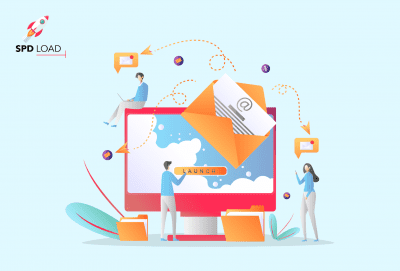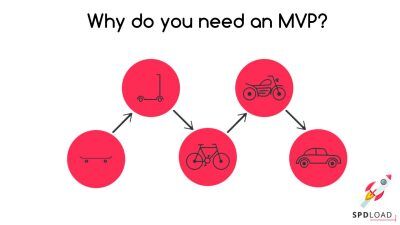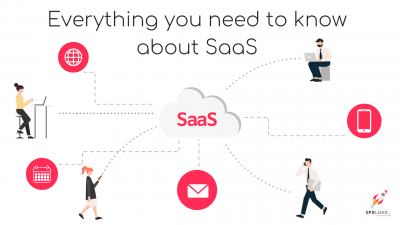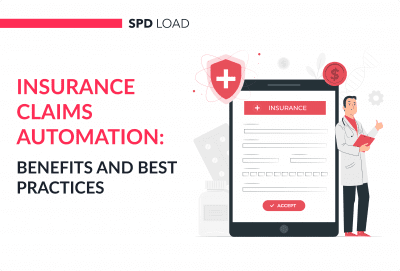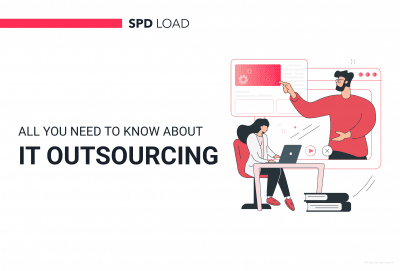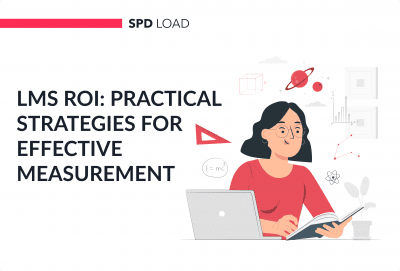Top Strategies for Successful LMS Implementation in Your Organization
- Created: Feb 21, 2025
- 11 min
Looking to implement LMS into your organization’s workflow but don’t know how to do it right?
We’ve got you covered.
In this blog article, we explore the LMS market and its driving factors, how to prepare a successful LMS implementation plan, and key factors to consider when choosing an LMS system.
Additionally, we explore common mistakes in LMS implementation and how to calculate LMS ROI. As a bonus, we share a comprehensive LMS implementation checklist you can refer to during LMS deployment.
If you are looking for custom LMS development services, you can count on the SpdLoad team.
Explore our app development services today
Learning Management System Market Overview
Before we dive into the LMS implementation project plan, let’s explore the market and the main driving factors for success.
According to the Grand View Research industry report, the global LMS market was estimated at $24.05 billion in 2024.
Driven by the growing demand for e-learning platforms across business, academic, and individual clients, the LMS market is projected to grow at a CAGR of 19.9% by 2030.
Since the hybrid and fully remote work models are on the rise now, organizations have increased their investments in employee training software development to support remote training and skill development.
On top of that, AI adoption enhances the capabilities of learning management systems and provides a personalized touch to learning experiences. In fact, AI’s impact is growing rapidly, and you might want to explore these AI statistics that highlight the trends you need to know. 
What Do LMS Platforms Do?
Learning management systems deliver educational materials in video, audio, simulations, and interactive formats.
They are used to the learning process, making it more engaging and captivating for both learners and educators.
More engagement means better retention, a more comprehensive learning process, and better outcomes.
Plus, the data on learner engagement, behavior, and performance can be used by teachers and trainers to personalize learning paths, identify areas for improvement, and measure the overall effectiveness of online training.
Gamification of the learning process, including badges, challenges, and points, can encourage active participation. According to the Journal of Interactive Learning research, gamified training modules show a 20% improvement in knowledge retention.
Overall there is a growing need for LMS platforms that can accommodate different learning styles and preferences.
Businesses are looking for an LMS that offers flexibility in learning methodology and multiple LMS integrations such as SSO, CRM, LRS, and more.
LMS are evolving to meet these demands. LMS providers are doing their best to offer adaptable solutions that fit with modern learning trends. 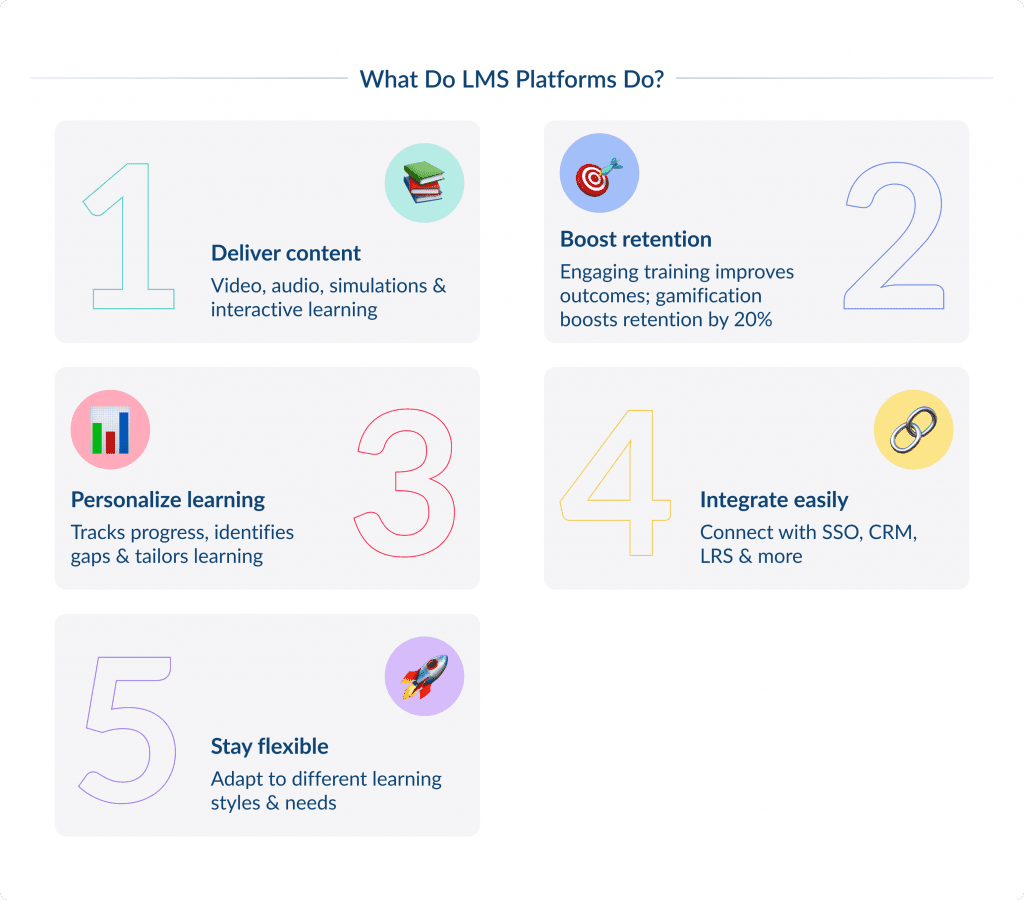
Now, let’s elaborate more on the LMS implementation process.
Preparation for Successful LMS Implementation
So, you’ve decided to implement LMS to elevate your training programs, customized learning paths, and learner progress tracking. That’s the right thing to do.
Additionally, LMS implementation is more cost-effective as there is no need for instructor fees, travel expenses, and physical training facilities. We will explore the ROI of LMS implementation in one of the next chapters.
There are several key steps to take to prepare for LMS implementation. Each of them will ensure a successful rollout.
Here is a structured approach to help you prepare effectively:
Step 1: Define Your Learning Objectives and Goals
First, you need to identify clear training goals that align with your business objectives and initiatives.
To do so, determine why you need LMS in the first place and what specific training goals you want to achieve.
Some of the goals can include:
- Skill development
- Knowledge retention
- Enhanced engagement and motivation
- Reduced training costs
- Compliance management
- Streamlined onboarding
You want to clearly identify the primary goals and objectives of implementing an LMS to achieve optimal results. Otherwise, you may just end up spending money and valuable resources on a training program that does not drive any results.
To avoid this, you need to tie each goal to measurable objectives and key results (OKRs) to track the impact of the LMS on your organization.
Some measurable OKRs you can track are:
- Training completion rates — are they increased, lower, or stay the same?
- User engagement — same here, is it higher, lower, or no changes?
- Learning satisfaction rates — do your employees enjoy the learning process, or is it like torture for them?
- Knowledge retention (can be measured through regular assessments)
- Skill applications — do your employees actually use the knowledge in their work?
- Performance metrics — has the training improved employee performance?
- Time-to-productivity — has the time-to-productivity of new hires increased?
- Reduced training costs — did the LMS help you save costs on training?
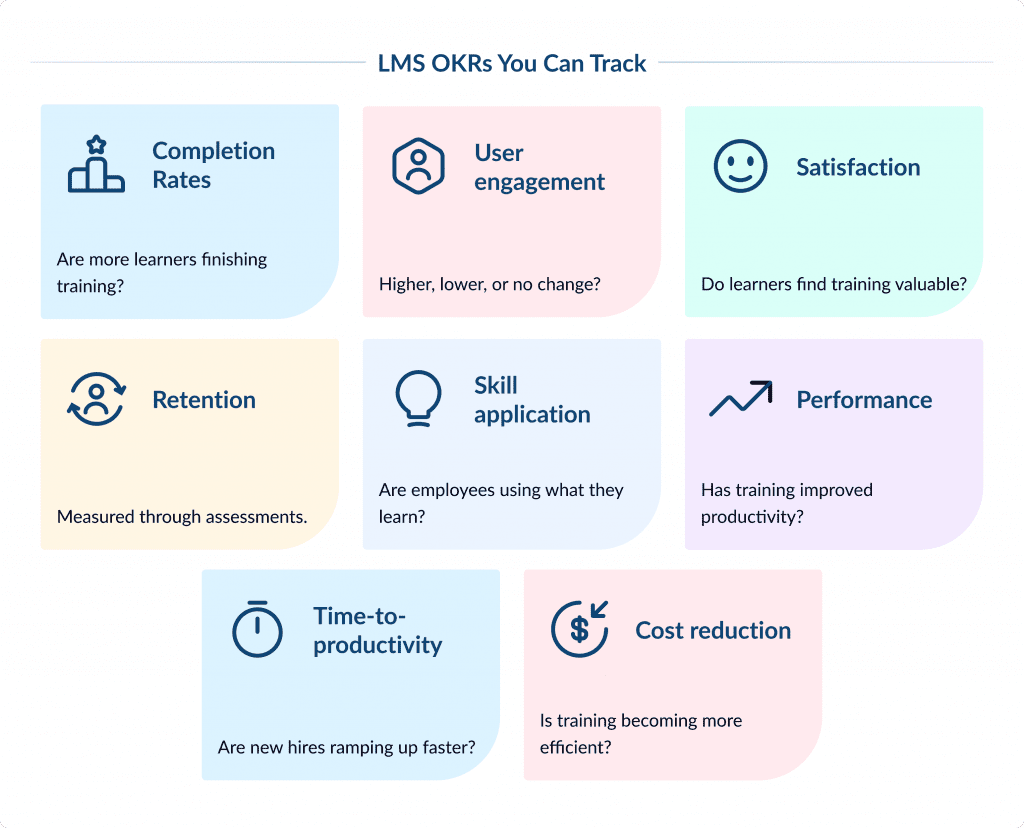
Step 2: Evaluate Your Resources and Establish a Timeframe
Once you’ve defined the learning objectives and goals, it is high time to gather critical information before starting the LMS project plan.
Determine the resources you need for LMS implementation.
Here are some of the key resources needed:
LMS implementation team
Assemble a team of administrators, IT personnel, trainers, and HR representatives to manage different aspects of the implementation process.
Subject matter experts
Subject matter experts develop and review content to ensure it meets organizational standards
Trainers and educators
They will help design and deliver training programs for users
IT infrastructure
To support the LMS
LMS subscription or development
Depending on whether you need a custom or off-the-shelf solution
LMS integrations
To integrate the LMS with existing systems like HR databases or single sign-on solutions
Testing and quality assurance
Functionality and user acceptance testing to ensure the LMS functions as expected
Ongoing support
Continuous support and resources to address user queries and technical issues
Once you’ve evaluated the resources you need for the learning management system implementation, you need to establish a timeframe.
The average LMS implementation timeline varies from a couple of months to a year, depending on the size of your company, system complexity, and whether it is on-premise or cloud-based.
On-premise LMS takes anywhere from 6 to 12 months to implement. This option requires more infrastructure setup and maintenance.
Cloud-based LMS implementation takes between 3 to 9 months to implement. Cloud-based solutions are generally faster to set up and more scalable. 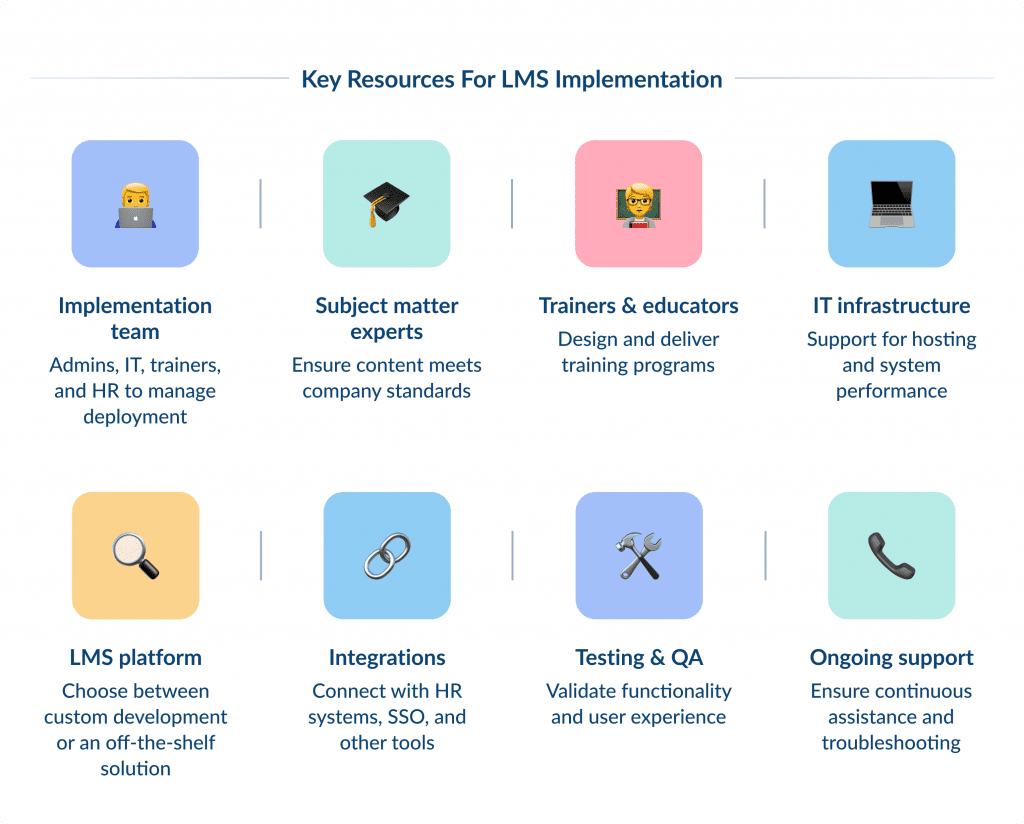
If you need a brand new learning management system, the education software development services can take from 6 months to a year, depending on features, team location, organizational goals, etc.
Feel free to contact us for a more personalized e-learning app development time estimate.
Step 3: Build Your Extended Team for a Smooth LMS Implementation Process
Once the core resources and timeframe are estimated, you need to assemble your LMS implementation dream team.
The team will include LMS administrators and representatives from HR, IT, Learning and Development, Training, and Management.
You need to define roles and responsibilities for each team member to streamline the implementation process and avoid miscommunication.
How to Choose the Right Learning Management System
When choosing the LMS vendor, make sure you consider the following key features:
| Category | Key Features | Why It’s Important |
|---|---|---|
| User Experience |
| Ease of use for learners and administrators, better engagement and adoption rates. |
| Content Management |
| Allows creating and sharing diverse content formats while maintaining industry standards. |
| Learning Delivery |
| Accommodates various learning styles and enhances flexibility for users. |
| Assessment & Feedback |
| Tracks learner performance and provides actionable insights for improvement. |
| Integration | Integration with HR systems CRM, ERP, or video conferencing tools | Seamless connectivity with existing organizational tools and workflows. |
| Analytics & Reporting |
| Data-driven insights to measure the effectiveness of training programs. |
| Gamification |
| Boosts motivation and engagement by incorporating elements of fun and competition. |
| Communication Tools |
| Facilitates collaboration and keeps learners informed. |
| Compliance Management |
| Helps meet industry-specific training requirements (like FERPA compliance) and track compliance easily. |
| Scalability |
| LMS grows with your organization and can support learners worldwide. |
| Security |
| Protects sensitive user and organizational data. Legal and privacy adherence. |
| Support & Maintenance |
| Smooth implementation and long-term usability of the LMS. |
Let's shape your startup's product vision together!
LMS Implementation Checklist
Implementing a learning management system is all about thorough planning and careful execution.
Here is a comprehensive checklist to guide you through the process.
To make it more convenient for you, we’ve separated the LMS implementation project plan into several key phases. 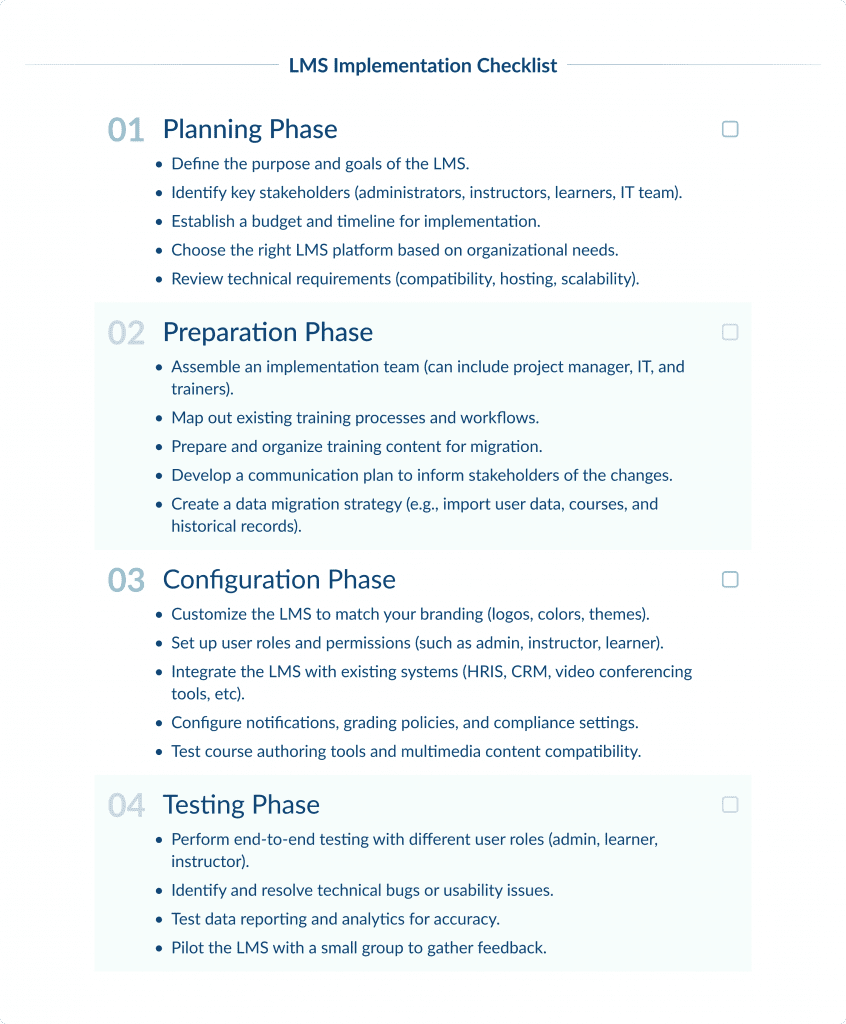
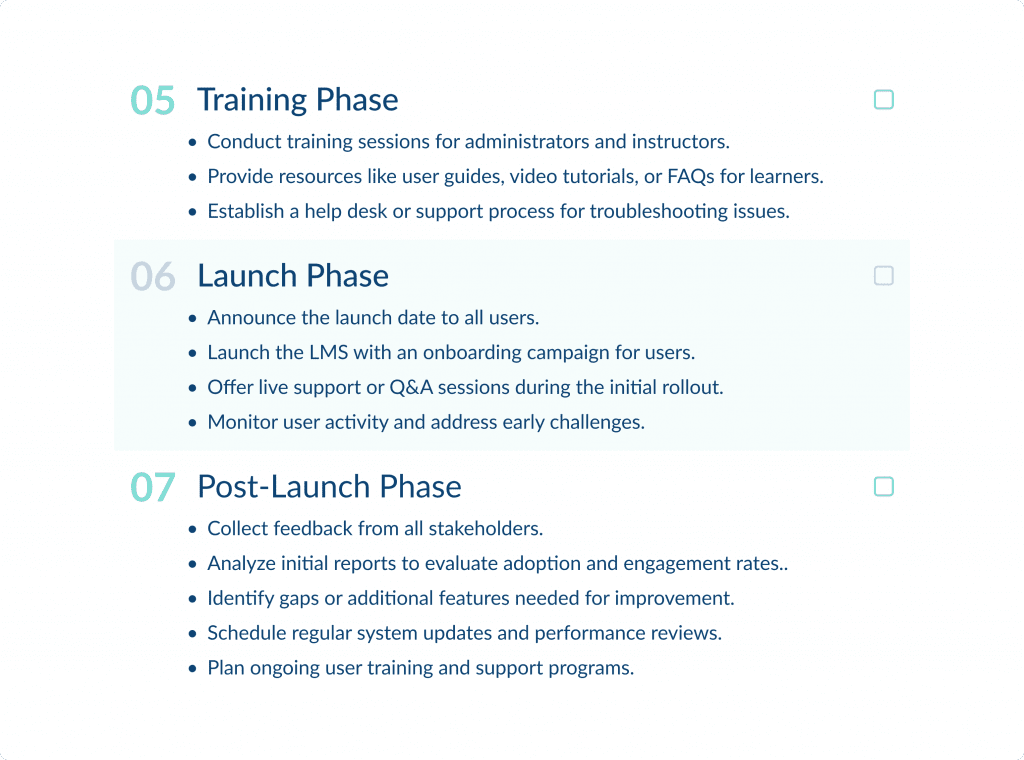
Common Mistakes of LMS Implementation
Before you implement an LMS, you should be aware of the common pitfalls to avoid.
Here are some common mistakes to watch out for during learning management system implementation:
Unclear Goals
The first mistake I would like to point out is when you start LMS platform implementation without clear objectives or measurable outcomes.
This can lead to wasting time and resources on a platform that doesn’t solve any tasks.
To avoid this, you should define specific, measurable goals that align with organizational objectives to guide the implementation process.
Not Involving Key Stakeholders
LMS implementation involves careful planning.
And the implementation plan should be approved by key stakeholders: users and decision-makers, early in the process.
When involving stakeholders from different departments, you ensure that the LMS implementation aligns with business goals and user needs.
Poor User Training
Insufficient user training leads to low adoption rates and user frustration.
There is no point in using the LMS platform if no one knows exactly how to do that.
To avoid this, develop comprehensive training programs for all user levels to ensure effective use of the LMS.
Ignoring System Connections
Not integrating the LMS with existing systems leads to inefficiencies and data silos.
Ensure the LMS integrates well with other organizational systems to enhance efficiency and data flow.
Not Planning for Growth
Choosing an LMS that cannot scale with organizational growth is a waste of money.
You need to select a flexible LMS that can adapt to future needs and expansions. This will save you costs in the long term.
Another option is to create a new LMS that will be customized to your needs and grow with you.
At SpldLoad, we can help you with e-learning platform development.
Inadequate Technical Support and Infrastructure
The mistake we can see quite often is when organizations underestimate the role of technical support for the learning platform.
Without tech support, using the platform is more challenging and can lead to lower adoption rates.
To avoid this, allocate sufficient resources for ongoing support.
Neglecting Course Design and Quality
Training materials should be not just educational. They need to captivate users, making the learning process more interesting and engaging.
If your courses fail to apply sound pedagogical principles to course design, this can lead to poor learning outcomes.
A well-designed LMS interface is crucial for user experience, as it affects how effectively information is retained and used.
Tools like discussion boards, forums, and chat functionalities encourage peer interaction. This not only creates a sense of community but also elevates the overall user experience.
Rushed Implementation
Rushing through the LMS implementation process without adequate planning and testing can lead to failure.
You need to adopt a gradual and phased approach to ensure thorough testing and user readiness.
Ignoring Compliance and Security
The educational industry is regulated by multiple standards, including FERPA and GDPR.
These ensure the safety of students’ private information.
Overlooking compliance with these standards may lead to fines and reputational losses.
Make sure the LMS you build meets all relevant compliance standards and conduct regular security testing to keep your corporate data safe.
Not Listening to Feedback
In the first few months, when your LMS is launched, you need to listen to the user feedback very carefully and passionately.
Encourage your users to share their thoughts, what they liked and disliked about the program, and if there is anything that would make their experience better.
These are valuable insights that can help you improve the system for those who actually use it.
And don’t just listen, act. Make necessary adjustments to improve the LMS experience. 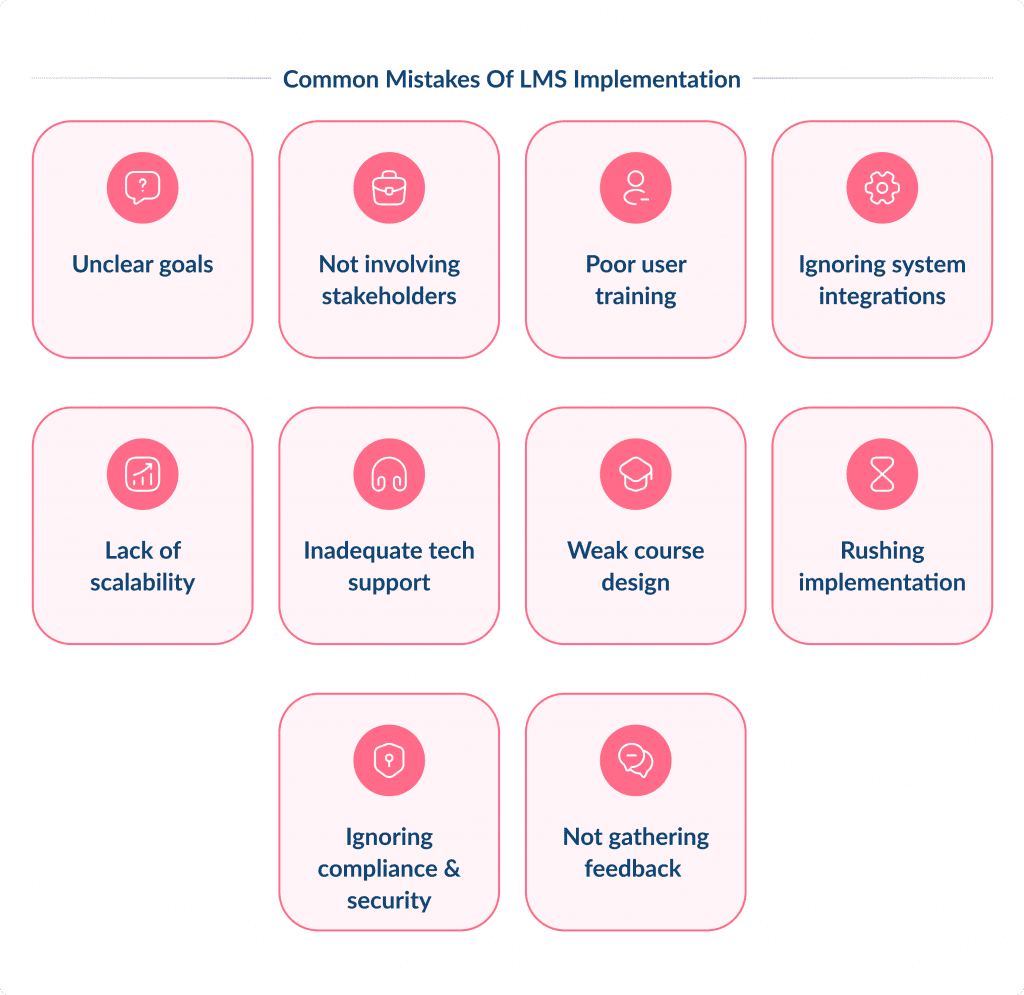
What Are the Business Benefits of LMS Implementation & How To Measure Them?
LMS is a great investment that comes with a lot of promises: more effective employee training, smoother onboarding, and enhanced productivity are just a few of them.
However, you can’t just implement the system and expect it to work miracles without knowing how to measure them. This is when the measuring of ROI enters the game.
The point is that even if the LMS you pick ticks all the boxes, it doesn’t mean it will deliver the results you expect.
The costs will add up, and the results are still far from what you’ve been hoping for.
Understanding ROI is crucial for evaluating the effectiveness of learning and development initiatives.
A range of internal factors and specifics of the LMS can impact the return on investment. These include:
- The size of your workforce
- The cost of the LMS
- Your labor costs
- Your current training times and costs
Here’s how you can break it down step by step to see if the numbers add up.
Step 1: Identify Fixed and Variable Costs
First, figure out how much the LMS will cost over time.
Fixed costs are predictable, like setup fees, initial training, or licensing.
Variable costs depend on usage, such as content updates, extra user licenses, or scaling storage.
For example, an off-the-shelf LMS might cost $12,000 per year in licenses, with an extra $2,000 for user expansion fees. Over 5 years, that adds up to $70,000.
A custom LMS, on the other hand, could have an upfront development cost of $80,000.
But because there are no ongoing licensing fees, the total 5-year cost might only rise to $100,000 when you include occasional updates.
While custom elearning app development often cost more at first, they can save money in the long run, eliminating recurring fees and expensive updates.
Step 2: Measure Benefits
Once you know the costs, focus on the benefits — both financial and operational.
Let’s say your company spends $1,200 per employee annually on instructor-led training.
With an LMS, you might cut that down to $300 per employee by automating courses and reducing travel costs.
If you have 100 employees, that’s an annual saving of $90,000 ($120,000 – $30,000).
Some advantages can’t always be tied to direct dollar amounts but still make a huge difference:
- Faster onboarding reduces the time it takes for new hires to start contributing to the projects.
- Avoiding potential fines or audits due to better compliance with training deadlines.
- Higher employee satisfaction leads to reduced turnover. It can save you a huge amount of money and time on hiring and training replacements.
Investing in employee wellness programs isn’t just good for your team — it’s good for business. Learn why.
Step 3: Calculate ROI
Here’s the simple formula:
ROI = ((Total Benefits – Total Costs) / Total Costs) * 100
Example 1: Off-the-Shelf LMS
Total 5-year cost: $70,000.
Annual savings: $90,000 from training cost reductions.
Total 5-year benefit: $450,000 ($90,000 x 5).
ROI = ((Total Benefits – Total Costs) / Total Costs) * 100
For every dollar spent, you get over five dollars in value.
Putting numbers to both the costs and the benefits, you’ll have a clear picture of whether your LMS is worth it.
Whether it’s saving money, improving productivity, or driving revenue, a well-implemented LMS can deliver real, measurable value — and make your investment more than worthwhile.
Conclusion: Best Practices for a Successful LMS Implementation
Your LMS implementation project plan should include several key stages such as planning, preparation, configuration, testing & quality assurance, training, launch, and post launch.
A successful LMS implementation process also depends on the LMS provider and the team you choose.
At SpdLoad, we help startups and enterprises navigate the complexities of LMS development, integration, and optimization.
Whether you’re building a new LMS or trying to make an existing system work better for you, our dedicated team is here to support your goals.
Let’s get in touch to discuss how we can collaborate and build an eLearning platform that is not just efficient but also cost-effective.




